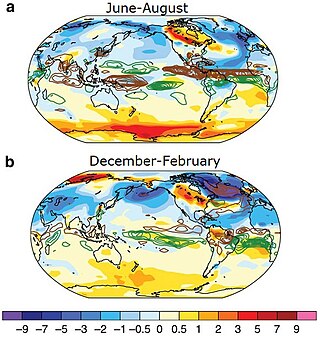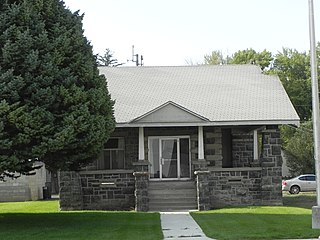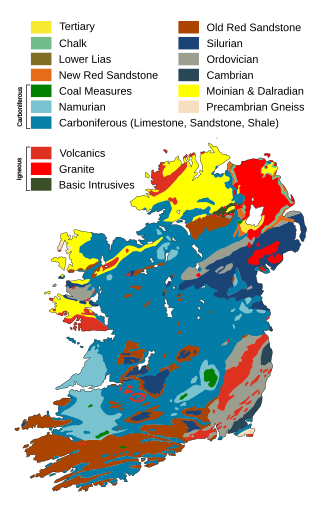This article needs additional citations for verification .(October 2020) |
The Niter Ice Cave is a geological feature approximately 3 miles south of the small southeastern Idaho town of Grace, Idaho.
This article needs additional citations for verification .(October 2020) |
The Niter Ice Cave is a geological feature approximately 3 miles south of the small southeastern Idaho town of Grace, Idaho.
The most probable explanation for the Niter Ice Cave is that thousands of years ago, a volcanic eruption formed a huge lava tube that eventually cooled to form this cave. Early settlers in the area found the cave to be a place to store their food and collect ice all year around. It has been a picnic spot and recreation site. There have been explicit drawings and graffiti on, around, and in the ice cave. [1]

The Pleistocene is the geological epoch that lasted from c. 2.58 million to 11,700 years ago, spanning the Earth's most recent period of repeated glaciations. Before a change was finally confirmed in 2009 by the International Union of Geological Sciences, the cutoff of the Pleistocene and the preceding Pliocene was regarded as being 1.806 million years Before Present (BP). Publications from earlier years may use either definition of the period. The end of the Pleistocene corresponds with the end of the last glacial period and also with the end of the Paleolithic age used in archaeology. The name is a combination of Ancient Greek πλεῖστος (pleîstos) 'most' and καινός 'new'.

The Younger Dryas was a period in Earth's geologic history that occurred circa 12,900 to 11,700 years Before Present (BP). It is primarily known for the sudden or "abrupt" cooling in the Northern Hemisphere, when the North Atlantic Ocean cooled and annual air temperatures decreased by ~3 °C (5.4 °F) over North America, 2–6 °C (3.6–10.8 °F) in Europe and up to 10 °C (18 °F) in Greenland, in a few decades. Cooling in Greenland was particularly rapid, taking place over just 3 years or less. At the same time, the Southern Hemisphere experienced warming. This period ended as rapidly as it began, with dramatic warming over ~50 years, which transitioned the Earth from the glacial Pleistocene epoch into the current Holocene.

Caribou County is a county located in the U.S. state of Idaho. As of the 2020 Census the county had a population of 7,027. The county seat and largest city is Soda Springs.

Shoshone is the county seat and largest city of Lincoln County, Idaho, United States. The population was 1,653 at the 2020 census. In contrast to the Shoshone Native American tribe for which it is named, the city's name is correctly pronounced "Show-shown", with a silent "e".

Niter or nitre is the mineral form of potassium nitrate, KNO3. It is a soft, white, highly soluble mineral found primarily in arid climates or cave deposits.

Fossil Mountain is located in the Teton Range, within the Jedediah Smith Wilderness of Caribou-Targhee National Forest, U.S. state of Wyoming.

Mount Takahe is a 3,460-metre-high (11,350 ft) snow-covered shield volcano in Marie Byrd Land, Antarctica, 200 kilometres (120 mi) from the Amundsen Sea. It is a c. 30-kilometre-wide (19 mi) mountain with parasitic vents and a caldera up to 8 kilometres (5 mi) wide. Most of the volcano is formed by trachytic lava flows, but hyaloclastite is also found. Snow, ice, and glaciers cover most of Mount Takahe. With a volume of 780 km3 (200 cu mi), it is a massive volcano; the parts of the edifice that are buried underneath the West Antarctic Ice Sheet are probably even larger. It is part of the West Antarctic Rift System along with 18 other known volcanoes.
Ruby City is a ghost town in Owyhee County, Idaho, United States. It was located along Jordan Creek about a mile below Silver City.

An ice cave is any type of natural cave that contains significant amounts of perennial (year-round) ice. At least a portion of the cave must have a temperature below 0 °C (32 °F) all year round, and water must have traveled into the cave’s cold zone.
Gem Valley is a rural valley in Caribou County, Bannock, and Franklin counties in Idaho, United States, so named for its local gemstones which can be found throughout the valley. It is approximately 20 miles (32 km) wide at its widest point east to west, and 60–70 miles (97–113 km) long north to south. By local definition, Gem Valley originates at the Chesterfield Reservoir to the north, and terminates at the Oneida Narrows Reservoir to the south.

The geology of Ireland consists of the study of the rock formations on the island of Ireland. It includes rocks from every age from Proterozoic to Holocene and a large variety of different rock types is represented. The basalt columns of the Giant's Causeway together with geologically significant sections of the adjacent coast have been declared a World Heritage Site. The geological detail follows the major events in Ireland's past based on the geological timescale.

Bixby State Preserve is a nature reserve located in southwestern Clayton County, Iowa, in the midwestern United States. It is located 3 miles (4.8 km) north of Edgewood. It is operated by the Iowa Department of Natural Resources as one of the Iowa state preserves.
Thatcher is an unincorporated community in Franklin County, Idaho, United States. Its elevation is 4,902 feet (1,494 m), and it is located at 42°24′32″N111°43′37″W. Although Thatcher is unincorporated, it has a post office, with the ZIP code of 83283; the ZCTA for ZIP Code 83283 had a population of 123 at the 2000 census.

This timeline of volcanism on Earth includes a list of major volcanic eruptions of approximately at least magnitude 6 on the Volcanic explosivity index (VEI) or equivalent sulfur dioxide emission during the Quaternary period. Other volcanic eruptions are also listed.
Cave Springs is a ghost town in Elk County, Kansas, United States.
Spratt is an unincorporated community in Muskingum County, in the U.S. state of Ohio.

Gregg Knob is a summit near Afton, West Virginia, in the United States. With an elevation of 3,150 feet (960 m), Gregg Knob is the 302nd highest summit in the state of West Virginia.
Bench is an unincorporated community in Caribou County, in the U.S. state of Idaho.
Hatch is an unincorporated community in Caribou County, in the U.S. state of Idaho.
42°32′00″N111°43′58″W / 42.53333°N 111.73278°W